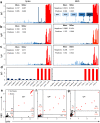This is a preprint.
Standardization of enzyme-linked immunosorbent assays for serosurveys of the SARS-CoV-2 pandemic using clinical and at-home blood sampling
- PMID: 32511472
- PMCID: PMC7265693
- DOI: 10.1101/2020.05.21.20109280
Standardization of enzyme-linked immunosorbent assays for serosurveys of the SARS-CoV-2 pandemic using clinical and at-home blood sampling
Update in
-
Standardization of ELISA protocols for serosurveys of the SARS-CoV-2 pandemic using clinical and at-home blood sampling.Nat Commun. 2021 Jan 4;12(1):113. doi: 10.1038/s41467-020-20383-x. Nat Commun. 2021. PMID: 33397956 Free PMC article.
Abstract
The extent of SARS-CoV-2 infection throughout the United States population is currently unknown. High quality serology is a key tool to understanding the spread of infection, immunity against the virus, and correlates of protection. Limited validation and testing of serology assays used for serosurveys can lead to unreliable or misleading data, and clinical testing using such unvalidated assays can lead to medically costly diagnostic errors and improperly informed public health decisions. Estimating prevalence and clinical decision making is highly dependent on specificity. Here, we present an optimized ELISA-based serology protocol from antigen production to data analysis. This protocol defines thresholds for IgG and IgM for determination of seropositivity with estimated specificity well above 99%. Validation was performed using both traditionally collected serum and dried blood on mail-in blood sampling kits, using archival (pre-2019) negative controls and known PCR-diagnosed positive patient controls. Minimal cross-reactivity was observed for the spike proteins of MERS, SARS1, OC43 and HKU1 viruses and no cross reactivity was observed with anti-influenza A H1N1 HAI titer during validation. This strategy is highly specific and is designed to provide good estimates of seroprevalence of SARS-CoV-2 seropositivity in a population, providing specific and reliable data from serosurveys and clinical testing which can be used to better evaluate and understand SARS-CoV-2 immunity and correlates of protection.
Figures






References
Publication types
Grants and funding
LinkOut - more resources
Full Text Sources
Miscellaneous
